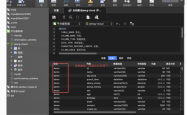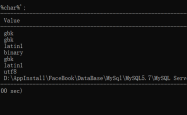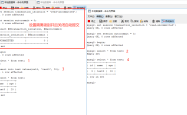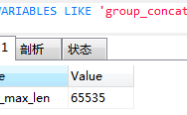Mysql常用运算符与函数汇总
我们先把数据表建好
?| 1 2 3 4 5 6 7 8 9 10 11 12 13 14 15 16 17 18 19 | use test; create table `employee`( emp_no int unsigned, emp_name varchar (30), emp_sex varchar (3), emp_age tinyint unsigned, sal double , history datetime ); insert into employee values (1, '张三' , '男' , 18, 5000, '2012-04-23' ), (2, '李四' , '男' , 27, 4500, '2013-05-23' ), (3, '王五' , '男' , 23, 4700, '2012-04-21' ), (4, '子龙' , '男' , 19, 3800, '2011-03-04' ), (5, '李白' , '男' , 15, 6200, '2015-09-09' ), (6, '刘备' , '男' , 28, 2500, '2016-02-11' ), (7, '吕布' , '男' , 21, 6000, '2010-10-18' ), (8, '尚香' , '女' , 16, 4500, '2011-09-26' ), (9, '小乔' , '女' , 15, null , '2013-07-05' ), (10, '大乔' , '女' , 16, 5000, '2017-09-01' ); |
常用的运算符:
1: 等于( = )
| 1 2 | select * from employee where sal = 3800; select * from employee where sal = null ; --这里查询不到为null的数据 |
2: 等于( <=> )
?| 1 2 | select * from employee where sal <=> 3800; select * from employee where sal <=> null ; --这里可以查询到为null的数据 |
3: is判断(null)
?| 1 2 | select * from employee where sal is null ; select * from employee where sal is not null ; |
4: null值判断还可以使用isnull();
?| 1 2 | select * from employee where isnull (sal); select * from employee where ! isnull (sal); |
5: 在区间(between)内 between min and max ps:这里是一个闭区间
select * from employee where sal between 4500 and 5000;
6: 不在区间内
select * from employee where sal not between 4500 and 5000; --null不为包括进去
7: and 和 or
?| 1 2 | select * from employee where sal not between 4500 and 5000 or sal is null ; select * from employee where sal = 4500 and emp_sex = '女' ; |
8: 小于(<), 大于(>), 小于等于(<=), 大于等于(>=)
select * from employee where sal >= 4500;
***************************************************************************************************************
数学函数
1: rand();
| 1 2 3 | select rand() from dual; --dual是一个伪表 select 1+1 from dual; select rand(); --可以简写 |
2: least(value1, value2, ...) 返回最小值
?| 1 2 | select least(54,76,4,65,76,87,87,56,65,654,45,23,1,76); select least(54,76,4,65,76,87,87,56,65,654,45,23,1,76) as min_value; --列名可以起一个别名 |
3: greatest(value1, value2, ...) 返回最大值
select greatest(54,76,4,65,76,87,87,56,65,654,45,23,1,76);
4: round(M, D); 返回M的四舍五入的值, D表示要保留几们小数,默认值是0
?| 1 2 | select round(1.69); select round(1.69, 1); |
5: abs() 绝对值
?| 1 2 | select 5-10; select abs (5-10); |
***************************************************************************************************************
汇总函数
1: avg();
?| 1 2 | select * from employee where sal >= 6000; select avg (sal) from employee where sal >= 6000; |
2: count()
?| 1 2 3 4 5 | select count (*) from employee; select count (emp_name) from employee; select count (sal) from employee; --打印9 这里会忽略null值 select count (*) from employee where sal >= 4000; select count (*) from employee where sal <= 4000 or sal is null ; |
3: sum()
select sum(sal) from employee where sal >= 6000;
4: min()
select min(sal) from employee;
5: max()
select max(sal) from employee;
***************************************************************************************************************
日期函数
1: 获取当前的日期时间
?| 1 2 3 4 | select now(), sysdate(), current_timestamp (); select now(6), sysdate(6), current_timestamp (6); ps: now(), current_timestamp ();没有区别, 表示sql开始执行时的时间 sysdate()表示这个函数开始时间 |
2: 获取当前日期
select curdate(); --只有年月日
3: 获取当前时间
select curtime(); --只有时分秒
4: 日期的加运算date_add
?| 1 2 3 | select history, date_add(history, interval '1 12:10' day_minute) from employee; --date_add(history, interval '1 12:10' day_minute) select history, date_add(history, interval '1-1' year_month) from employee; --date_add(history, interval '1-1' year_month) select history, date_add(history, interval '1' second ) from employee; --date_add(history, interval '1' second) |
5: 日期的减运算data_sub
select history, date_sub(history, interval '1-1' year_month) from employee;
6: 计算日期差
select history, sysdate(), datediff(sysdate(), history) from employee; --以天数来表示
7: 获取日期的指定部分(把日期转换为指定的格式) date_format()
?| 1 2 3 | select history, date_format(history, '%Y年%m月%d号' ) from employee; select history, date_format(history, '%d号' ) from employee; select history, date_format(history, '%Y年%m月%d号 %H时%i分%s秒' ) from employee; |
8: 计算出一个日期是星期几
select history, dayname(history) from employee;
9: 中文日期字符串转换日期str_to_date()
| 1 2 | insert into employee values (11, '张飞' , '男' , 22, 3000, '2017年02月01号' ); --报错 insert into employee values (11, '张飞' , '男' , 22, 3000, str_to_date( '2017年02月01号' , '%Y年%m月%d号 %H时%i分%s秒' )); |
insert into employee values(12, '二哥', '男', 22, 3000, str_to_date('2017年02月01号 23时02分02秒', '%Y年%m月%d号 %H时%i分%s秒'));
insert into employee values(12, '二哥', '男', 22, 3000, str_to_date('2017年02月01号 11时02分02秒', '%Y年%m月%d号 %h时%i分%s秒'));
ps: 如果是h则表示12小制, 如果是大H则表示24小明制;
字符串函数
1: left(str, len) 返回字符串str的左端len个字符
select left('abcdefg', 5);
2: length()
select length('abcdefg');
3: lower(str) 返回小写的字符串str
select lower('HELLO');
4: substring() 取子字符串, 第二个参数是截取的起始位置, 第三个参数是要截取的长度
select substring('helloworld',2,3);
5: concat() 字符串拼接
select concat(emp_name, '员工') from employee;
6: replace(替换
select replace(emp_name, '李', '老') from employee where emp_name = '李四';
原文链接:http://www.cnblogs.com/wadmwz/archive/2017/09/20/7558776.html
1.本站遵循行业规范,任何转载的稿件都会明确标注作者和来源;2.本站的原创文章,请转载时务必注明文章作者和来源,不尊重原创的行为我们将追究责任;3.作者投稿可能会经我们编辑修改或补充。










